Austin K8
(25cwt 3 way Van)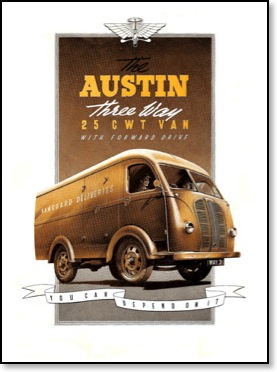
It was on the 25th June 1946 to mark the production of the millionth motor car, That during the celebrations the invited guests were permitted to examine the prototype of a new 25cwt van that was nearing completion.
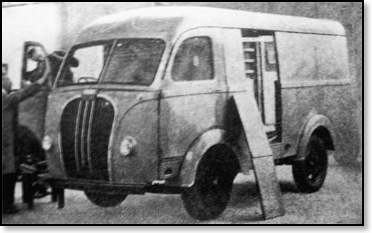
K8 Mock-up
Note different grill to production version
probable done to aid engine cooling
Work on the K8 as it was called in its prototype form, started in early 1946. But it soon became known as the 'Three-Way' van owing to its arrangement of double doors on both the nearside and offside, as well as at the rear, providing excellent access to the loading bay, it was on occasions incorrectly referred to as the 'Freeway'. It was a very forward looking design with its curved front and high driving position, making the visibility excellent compared to the competition.
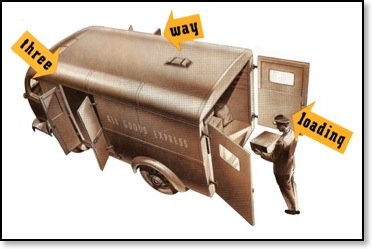
Production commenced early in 1947 at a cost of £535. Various changes had been made from the prototypes, which included the radiator grille, front bumper, access steps along with the wheels. It had a very small wheelbase considering that it had a pay load of 25 cwt, and this made it very nimble. It was powered by the Austin 2,199cc engine OHV petrol engine which had recently been installed in the Austin 16 car.The forward control cab gave good visibility a partition with window separates the cab from the steel body, with composite doors and toughened glass. Although the final assemble of the van was done at Longbridge. The contract for the bodies was give to Carbodies who had their factory in Holyhead Road Coventry. The body had a timber frame with steel sheets attached, even the doors had a wooden frame. The large front windows gave a good view of the road, the drivers side could be opened. Both the front doors had wind-down widows.
You could order a ambulance conversion on the K8 which was factory built and called the Welfarer K8/AA. This had the track increased by 1'' and was fitted with low pressure tyres (9.00 x 16). The suspension was also altered to give a softer ride, by different road springs and shock absorber settings.
Access to the rear accommodation could be through the L/H side door, or at the back via normal van doors by using steps that when folded away formed part of the floor. The floor area was covered in Magnesite, which was a composition of Magnesium oxide with a wood flour filler.
A roof mounted air intake directed air through a filter and then onto a Clayton air conditioning system that had a radiator feed from the engine cooling system. By means of a interior thermostat the temperature in the back could be set.
You could order various combinations of seats and stretchers to suit your requirements. The cost of the ambulance without the stretchers/seating was £805.
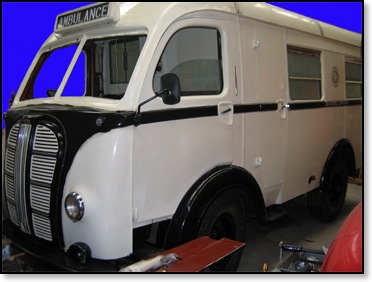
There are only two known Welfarer Ambulaces in the UK
This one featured in the film Quartermass Experiment
Jensen Motors Ltd brought out a pick-up version based on the chassis/cab in 1949 which was priced at £565 and sold through the Austin dealers. Later that year the basic van price was increased to £645
This unique vehicle proved to be popular and in 27 months around about 3,500 had been sold. Over the years there were various price increases, but in May 1950 the Government imposed Purchase Tax at 33% on commercial vehicles, the only exception was the ambulance and various municipal and emergency vehicles. This tax increased the basic van to £824 and the pick-up version to £711 in primer and £735 in standard colour.
The company decided to enter the North American market in late 1947 but sales were very slow. But in 1950 sales started to increase and in 1951 an exhibition of all Austin commercial products was opened in Vancouver.
So from the first vehicles been produced in 1947 to the last one coming off the line on September 1954 a total of over 26,500 had been made.
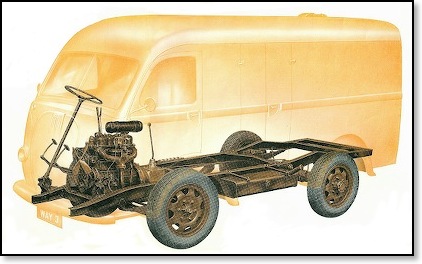
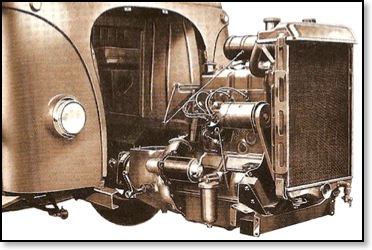
This view shows how easily the engine and gearbox could be removed 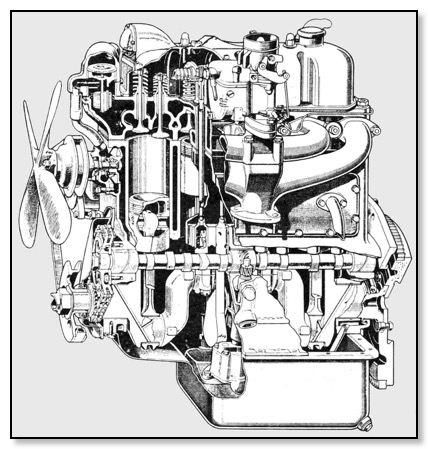
K8 Engine 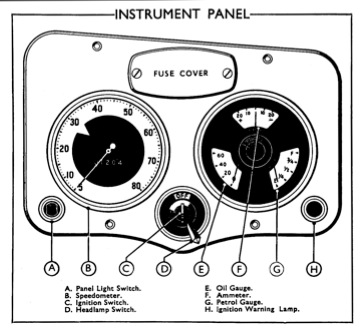
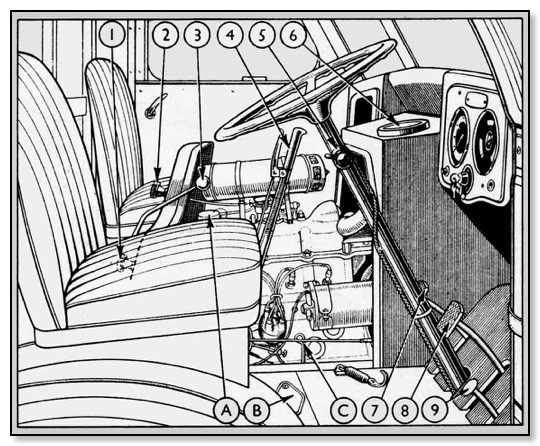
A. Engine Oil Filler Cap B. Inspection Cover, Brake Fluid
C. Engine Oil dipstick 1. Starter Switch 2. Choke Control
3. Gear Change Lever 4. Handbrake Lever 5. Horn & Dip-switch
6. Radiator Filler Cap 7. Clutch Pedal 8. Footbrake Pedal
9. Accelerator Pedal 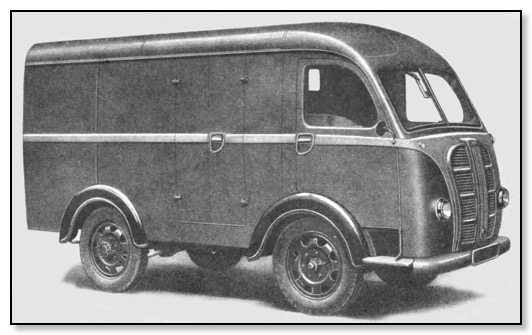
Van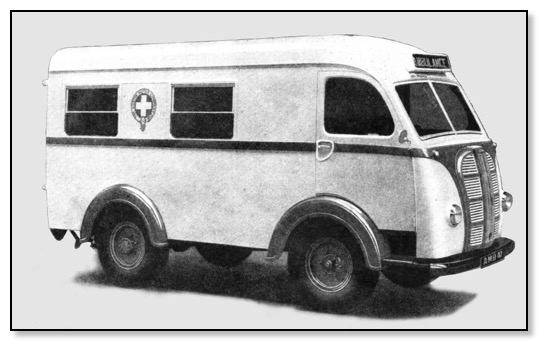
Austin Welfarer Convertible & Hospital Tender
Date when launched late 1947
Discontinued in 1954
Total produced not known
Engine
Petrol
2,199 cc 65 bhp at 3,700 rpm Max torque 115 lbs/ft at 1,900 rpm
Main measurements
Length 15ft 7ins Width 6ft 5ins Height 8ft 1.5ins
Wheelbase 7ft 9ins Track front & rear 5ft 1ins
Price ex Works In Grey Primer March 1947 Van £535 Chassis Cab £409, Chassis £340
Standard Colours Single Colour £28 Dual Colour £35
May 1953
Van £841 Chassis Cab £678, Chassis £602 All in grey primer
Van Full forward control with integral body and cab. Steel construction with composite doors Toughened glass and screen. Partition with window between cab and body
It was available as a van or chassis cab and because of this various conversions were carried out by coach builders.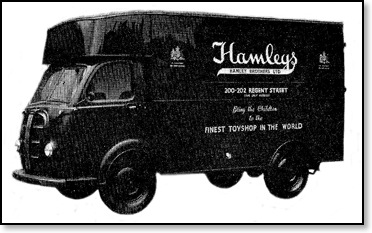
Even Hamleys had a fleet of K8's
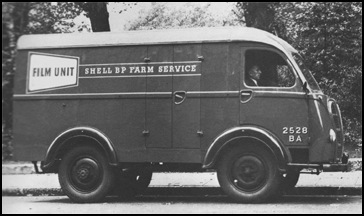
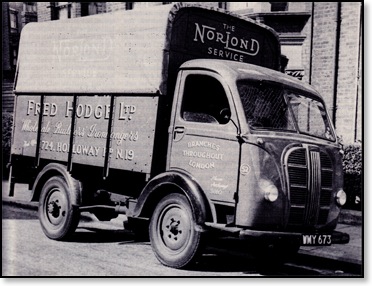
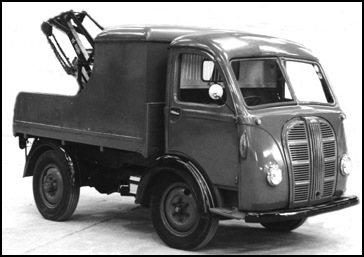
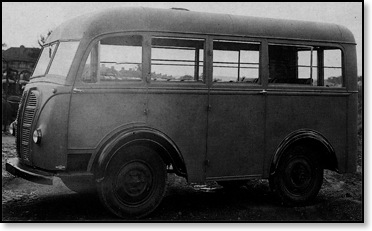
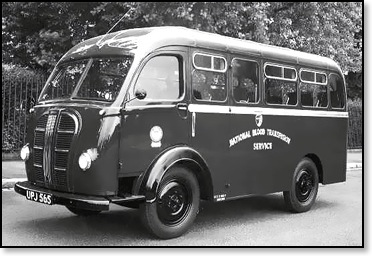
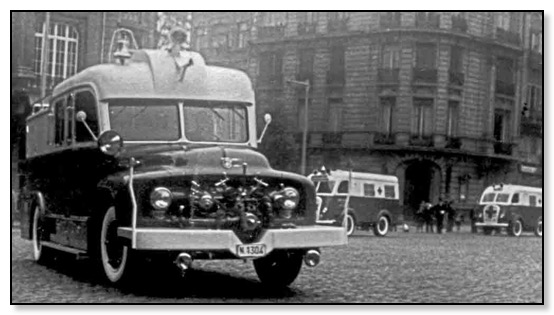
Austin Welfarer's used in the municipal police town of Saint-Gilles-lez-Bruxelles (Brussels area).
Until mid sixties, this municipal police corps also cared for the Fire and Emergency Service.
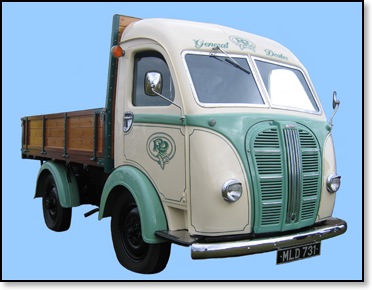
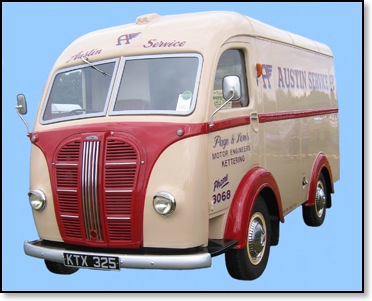
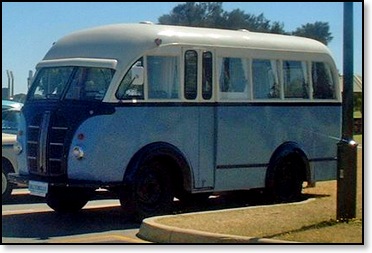
This is a K8 bus that was built from a chassis cab by Boltons of Perth in 1954. It is now owned by Pete & Sandie Stevens in Western Australia.
Austin Camper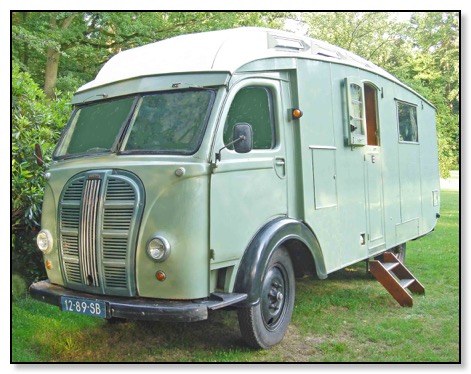
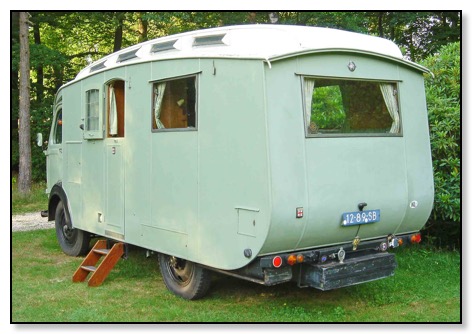
The camper was built in 1950 by Winchester for two Scottish sisters. They planned to travel through the continent, but when in London one of them fell ill and died in hospital. The remaining sister did not want to continue traveling in the camper. So it was put up for sale in London, and was bought by my great grandfather who in 1952 lived in Chertsey.
It stayed in the family, and in 1976 was moved to the Netherlands. The camper is entirely original having had no restoration work carried out, and has never let us down. Ernst Jan Krudop. Netherlands
___________________________
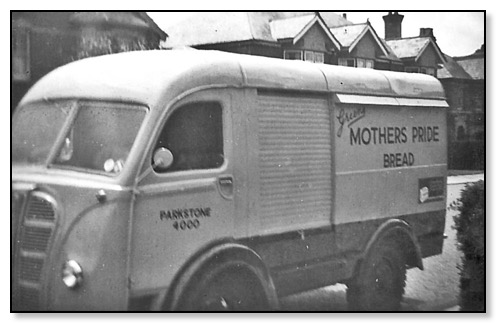
Memories of a K8 van
I travelled many miles in one as a baker's 'lad' in the late 50's and early 60's. I grew very fond of the vehicle in spite of being heater-less and subject to the toxic fumes inhaled from the engine casing that kept us company in the cab. Apart from those obvious defects, it had wind-up windows and a stylish but cheerful looking 'face'.
The local baker who had a sizeable fleet of K8's was G.W.Green of Alder Road Bakery in Parkstone, Poole. The only difference in construction to the standard vehicle was its roll-up shutters replacing the side doors. These were used as cake compartments and fitted out with shelves to house individual wooden trays.
The first K8's I recall were painted white with (I believe) the lower half in red which made an attractive livery. This was superceded in the mid 60's with the advent of the Mother's Pride sliced loaf when the colours were changed to a miserably drab beige and maroon later to change back again before the Bakery was sold by its owners J Arthur Rank of Hovis fame.
I recall that Greens had petrol engined K8's except for one with a diesel engine that was laboriously sluggish. In my school days, I can also recall having a trip in a cream Welfarer ambulance bearing the Dorset County Council crest. It was a bit sparse in the back but did the job adequately. The lad I accompanied to hospital however appeared to be bleeding more profusely from his head wound at the end of his rocky ride than when he set out.
John
"THREE-WAY" 25 CWT. VAN AND "WELFARER" AMBULANCE Specification
ENGINE-Bore 31in. (79.4 mm.) ; stroke 41in. (111.1 mm.) capacity 134.1 cu. in. (2,199 c.c.) ; R.A.C. rating 15.63 h.p.; b.h.p. 65at3,700r.p.m.; m~.torque I 15lbs.ft.at 1 900 r.p.m.; compression ratio 6.85 to 1. Cylinders-Four cylinders In special cast iron, Integral with crank case. Full length water jackets. Detachable cut iron cylinder head, carrying Valve gear. Crankshaft-Forged steel counterbalanced crankshaft supported by three detachable "Thinwall" bearings. Connecting Rods--Forged steel with detachable "Thinwall" big-end bearings. Pistons Aluminium alloy with anodised surface. Split ski" type with two compression rings and one scraper. Camshaft-Forged steel camshaft supported by three "Thinwall" bearings and driven by a duplex roller chain with a synthetic rubber tensioned rims to give quiet operation. Valves Overhead valves, push rod operated. Silicon chrome steel inlet valves. Exhaust valves of heat and corrosion resisting steel. Lubrication-Pressure gear pump forces oil to all main, big-end and camshaft bearings. Each main bearing oil feed is supplied from a circular channel cut in the bearing housing which provides a uniform feed of oil between the bearing surfaces. Big-end bearing lubrication, from a special oil feed in the crankshaft, also provides for jet lubrication of the cylinder walls. Oil from the camshaft front bearing on to the timing chain, is guided by deflectors fitted to the camshaft gear. T~.0 overhead valve rocker shaft is fed by oil from the camshaft centre bearing. Oil capacity 10 pints (5.6 litres), plus 2 pints (1.12 litres) for the full-flow Tecalimit filter. Oil pressure 50 to 55 lbs. per sq. in. working pressure. 26 lbs. per sq. in. idling pressure. Cooling-Water pump and fan with thermostat control. A four blade fan draws air through a patent radiator which prevents the loss of cooling water and anti-freeze either by splash or expansion. Cooling system capacity 21 pints (11.7 litres). Approximately 22 pints (12.5 litres) on the Ambulance. Ignition-Coil with automatic advance and retard, by vacuum control. Dynamo-12-volt, fan ventilated, with compensated voltage control. Starter-Lucas starter with manual operated control. Fuel System-Fuel from a 10 gallon (45 litres) tank on the left hand side of the chassis is fed by an AC mechanical Pump to a Zenith downdraught carburettor. A "T" type oil wetted gauze air intake filter is fitted. Mountings-The engine and gearbox unit Is flexibly mounted on live rubber mountings. CLUTCH-Borg and Beck 9 in. (22.8 cm.) diameter dry single-plate with spring cushion drive and light pedal action. Total frictional area 66.2 sq. in. (427 sq. cm.). GEARBOX-Four speeds forward and reverse with centre lever control. Straight tooth lst and 2nd gears with constant mesh helical 3rd gear, layshaft mounted on ball and roller bearings. Oil capacity 5* pints (3.09 litres). TRANSMISSION ON-Open propeller shaft with Hardy-Spicer needle roller bearing universal joints.
REAR AXLE-Fully floating rear axle with straddle mounted pinion and spiral bevel final drive gears. Taper roller bearings are used for , h . hubs and differential, and pre-loaded taper roller bearings for the pinion. Oil capacity 7 pints (3.92 litres). OVERALL GEAR RATIOS-6.57; 10.91 ; 19.13 ; 31.3 to I with 31.15 reverse.
ROAD SPEEDS AT 1,000 R.P.M.-Van : Top 14.85 m.p.h.; third 8.93 m.p.h.; second 5.09 m.p.h.; first 3.11 m.p.h. Ambulance : Top IS.24 m.p.h.; third 9.16 m.p.h.; second 5.22 m.p.h.; first 3.19 m.p.h. FRONT AXLE AND STEERING-The front axle is a toughened steel drop-forging of I section changing to rectangular section from the spring pads to the steering swivels, Taper roller bearings are used for the front hubs and the steering is Bishop cam gear with a ratio of 16 to 1. Steering wheel of 171in. diameter with a cellulose acetate covering. SUSPENSION-Semi-elliptic springs front and rear, mounted above axles. Hydraulic shock absorbers front and rear. Auxiliary leaves on van rear springs. BRAKES Girling-hydraulic with two leading shoe brakes front and rear. The pedal operates all four brakes, the handbrake operating mechanically on the rear wheels only. Total brake shoe lining area 184 sq. In. (1, 187 sq. cm.). WHEELS AND TYRES-Pressed-steel wheels with ventilation holes. Spare wheel carried at rear. Van : Dunlop 32 x 6 tyres, single front and rear. Pressures : front 55 lbs. per sq. in.; rear 65 lbs. per sq. In. Ambulance : Dunlop 16 x 9 tyres, single front and rear. Pressures 40 ibs. per sq. in. front and rear. FRAME-Pressed-steel frame with four cross members. Front cross member detachable to facilitate removal of power-unit. ELECTRICAL- 12-volt battery of 63 amp. hour capacity at 10 hour rate, accessible through trap in van body floor and under attendant's seat in ambulance stretcher compartment. Positive earth. Flush fitting headlamps with dip switch control. Flush fitting side lamps. Combined stop- and tail-lamps. Electric horn and windscreen wiper. Additional on Ambulance-Interior light and rear flood ]amp. Illuminated front sign. Clayton Dewandre interior heater with thermostat control. INSTRUMENTS-Ignition warning lamp, oil and petrol gauges, ammeter and speedometer with total readings. Concealed illumination for instruments. VAN BODY-Full forward control with integral body and cab. Steel construction with composite doors. Toughened glass in windows and screen. Partition with window between cab and body. Comfortable and adjustable seats for driver and mate. Bearing plates for body floor. Wide opening rear doors. Body side doors, behind cab partition, on both sides of vehicle. Combined barrel type ignition and door key for Use on body doors and driver's door. The cab left hand door is locked from inside. Full kit of tools.
AMBULANCE BODY-Full forward control with Integral body and two seater cab. Steel construction with composite doors. lsoflex material In body sides for thermal insulation and sound damping. Toughened glass for cab windows and screen. Semi-opaque windows for stretcher compartment. Partition, with communicating window, between cab and body. Wide opening rear doors with individual locking handles. Folding rear step. Recessed door handles. Hygienic moulded floor covering. Side door on left-hand side behind cab partition. Individual seat for attendant in stretcher compartment. STRETCHER EQUIPMENT : The "Welfarer" Convertible Ambulance or Hospital Tender may be supplied with different variations of the following stretcher equipment. (a) Single stretcher bearer with seat for six persons or with dual purpose seat or stretcher bearer, as alternative to seat. (b) "Carcer" double stretcher bearer with seating for six persons or with dual purpose seat or stretcher bearer, as alternative to seat. (c) Two single stretcher bearers.
(d) Two full length seats for accommodating twelve persons.

